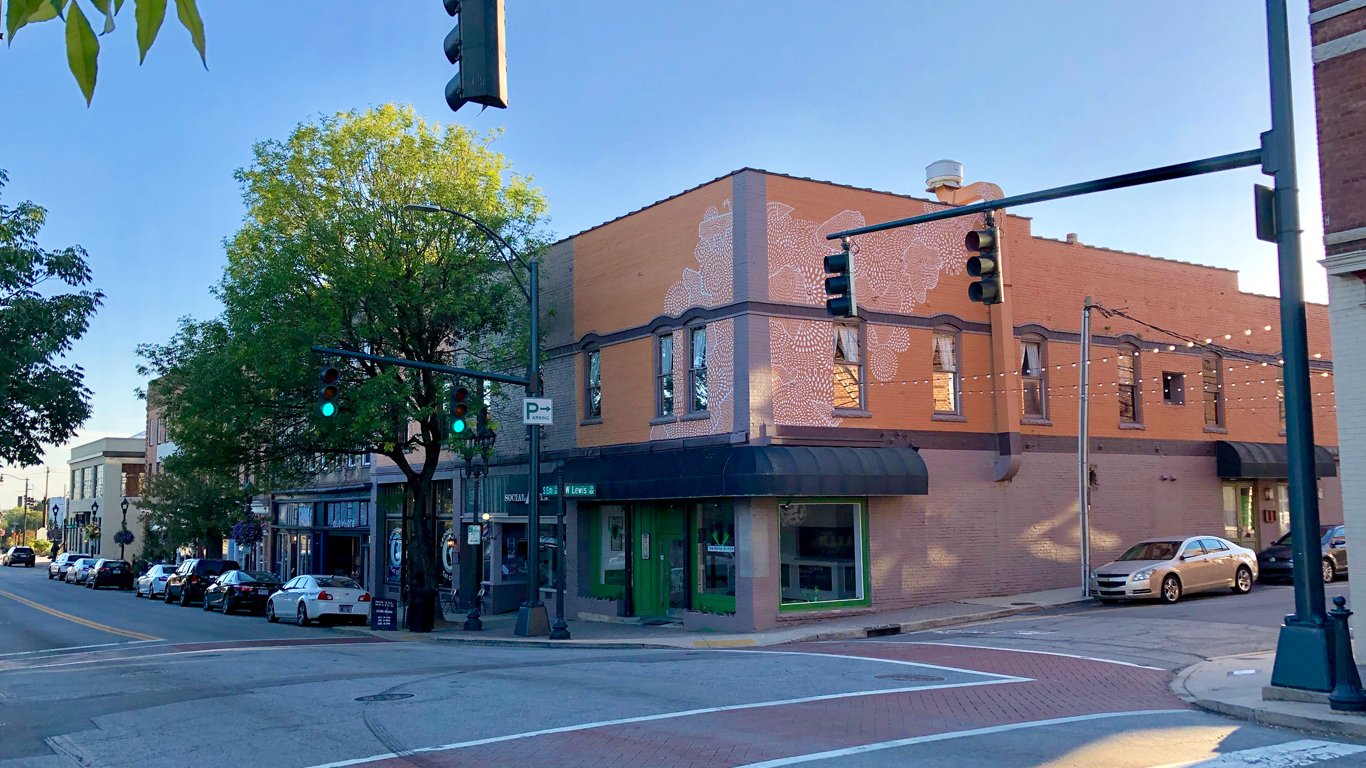

The U.S. has reported more than 79.6 million confirmed COVID-19 cases as of April 12. There have been more than 978,000 reported deaths from COVID-19-related causes — the highest death toll of any country.
The extent of the spread of the novel coronavirus continues to vary considerably from state to state, and from city to city. Even as the number of daily new cases is flattening or even declining in some parts of the country, it is surging at a growing rate in others.
Nationwide, the number of new cases is growing at a steady rate. There were an average of 8.9 daily new coronavirus cases per 100,000 Americans in the week ending April 12, essentially unchanged from the week prior, when there were an average of 8.8 daily new coronavirus cases per 100,000 people.
Metropolitan areas with a high degree of mobility and a large population may be particularly vulnerable to outbreaks. While science and medical professionals are still studying how exactly the virus spreads, experts agree that outbreaks are more likely to occur in group settings where large numbers of people routinely have close contact with one another. Cities with high concentrations of dense spaces such as colleges, correctional facilities, and nursing homes are particularly at risk.
The city with the highest seven-day average of new daily COVID-19 cases per capita is in North Carolina. In the Goldsboro, NC, metro area, there were an average of 93.6 daily new coronavirus cases per 100,000 residents in the week ending April 12, the most of any U.S. metro area. Other cities where COVID-19 is growing the fastest include Syracuse, NY; Ithaca, NY; and Wichita Falls, TX.
To determine the metropolitan area in each state where COVID-19 is growing the fastest, 24/7 Wall St. compiled and reviewed data from state and local health departments. We ranked metropolitan areas according to the average number of new daily COVID-19 cases per 100,000 residents in the seven days ending April 12. Data was aggregated from the county level to the metropolitan area level using boundary definitions from the U.S. Census Bureau. Population data used to adjust case and death totals came from the U.S. Census Bureau’s 2019 American Community Survey and are five-year estimates. Unemployment data is from the Bureau of Labor Statistics and is seasonally adjusted.

Alabama: Montgomery
Avg. new daily cases in Montgomery in week ending April 12: 13.0 per 100,000
Avg. new daily cases in Montgomery in week ending April 5: 4.5 per 100,000
COVID-19 cases in Montgomery as of April 12: 96,326 (25,787.1 per 100,000)
Peak pandemic unemployment in Montgomery: 14.7% (April 2020)
Montgomery population: 373,544 (137.7 people per sq. mi.)

Alaska: Anchorage
Avg. new daily cases in Anchorage in week ending April 12: 23.2 per 100,000
Avg. new daily cases in Anchorage in week ending April 5: 20.9 per 100,000
COVID-19 cases in Anchorage as of April 12: 137,625 (34,501.1 per 100,000)
Peak pandemic unemployment in Anchorage: 14.8% (April 2020)
Anchorage population: 398,900 (15.2 people per sq. mi.)
These are all the counties in Alaska where COVID-19 is slowing (and where it’s still getting worse).

Arizona: Phoenix-Mesa-Chandler
Avg. new daily cases in Phoenix in week ending April 12: 19.9 per 100,000
Avg. new daily cases in Phoenix in week ending April 5: 22.3 per 100,000
COVID-19 cases in Phoenix as of April 12: 1,404,380 (29,493.8 per 100,000)
Peak pandemic unemployment in Phoenix: 12.8% (April 2020)
Phoenix population: 4,761,603 (326.9 people per sq. mi.)

Arkansas: Jonesboro
Avg. new daily cases in Jonesboro in week ending April 12: 4.0 per 100,000
Avg. new daily cases in Jonesboro in week ending April 5: 11.5 per 100,000
COVID-19 cases in Jonesboro as of April 12: 45,613 (34,755.1 per 100,000)
Peak pandemic unemployment in Jonesboro: 9.3% (April 2020)
Jonesboro population: 131,241 (89.5 people per sq. mi.)

California: Fresno
Avg. new daily cases in Fresno in week ending April 12: 14.1 per 100,000
Avg. new daily cases in Fresno in week ending April 5: 15.1 per 100,000
COVID-19 cases in Fresno as of April 12: 253,824 (25,781.5 per 100,000)
Peak pandemic unemployment in Fresno: 16.7% (April 2020)
Fresno population: 984,521 (165.2 people per sq. mi.)
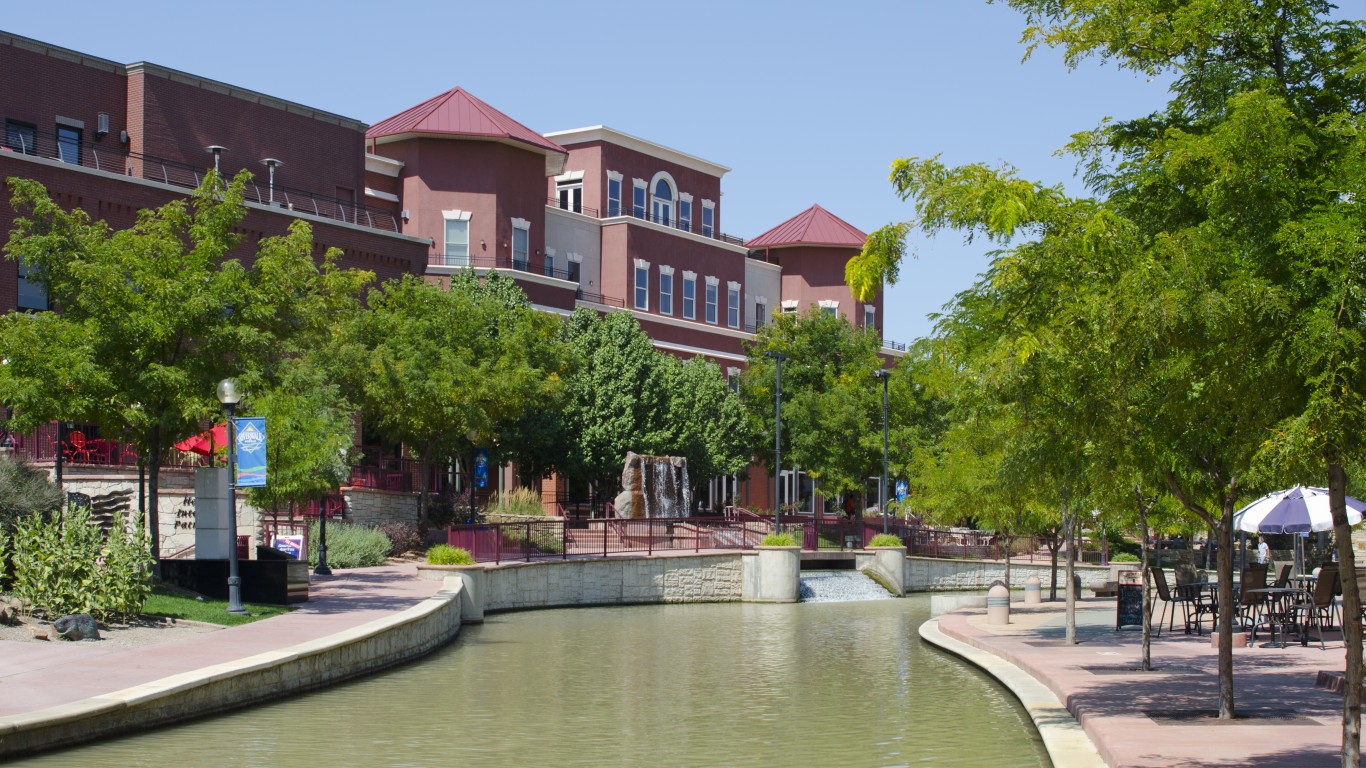
Colorado: Pueblo
Avg. new daily cases in Pueblo in week ending April 12: 20.6 per 100,000
Avg. new daily cases in Pueblo in week ending April 5: 25.2 per 100,000
COVID-19 cases in Pueblo as of April 12: 45,934 (27,674.1 per 100,000)
Peak pandemic unemployment in Pueblo: 11.8% (April 2020)
Pueblo population: 165,982 (69.6 people per sq. mi.)

Connecticut: Bridgeport-Stamford-Norwalk
Avg. new daily cases in Bridgeport in week ending April 12: 18.7 per 100,000
Avg. new daily cases in Bridgeport in week ending April 5: 13.9 per 100,000
COVID-19 cases in Bridgeport as of April 12: 203,593 (21,568.7 per 100,000)
Peak pandemic unemployment in Bridgeport: 10.6% (July 2020)
Bridgeport population: 943,926 (1,510.5 people per sq. mi.)

Delaware: Dover
Avg. new daily cases in Dover in week ending April 12: 7.8 per 100,000
Avg. new daily cases in Dover in week ending April 5: 10.4 per 100,000
COVID-19 cases in Dover as of April 12: 50,229 (28,426.3 per 100,000)
Peak pandemic unemployment in Dover: 17.3% (May 2020)
Dover population: 176,699 (301.4 people per sq. mi.)

Florida: Miami-Fort Lauderdale-Pompano Beach
Avg. new daily cases in Miami in week ending April 12: 11.4 per 100,000
Avg. new daily cases in Miami in week ending April 5: 9.9 per 100,000
COVID-19 cases in Miami as of April 12: 2,164,355 (35,535.6 per 100,000)
Peak pandemic unemployment in Miami: 13.8% (April 2020)
Miami population: 6,090,660 (1,199.6 people per sq. mi.)

Georgia: Columbus, GA-AL
Avg. new daily cases in Columbus in week ending April 12: 16.7 per 100,000
Avg. new daily cases in Columbus in week ending April 5: 14.5 per 100,000
COVID-19 cases in Columbus as of April 12: 66,852 (20,930.4 per 100,000)
Peak pandemic unemployment in Columbus: 12.8% (April 2020)
Columbus population: 319,402 (114.6 people per sq. mi.)

Hawaii: Urban Honolulu
Avg. new daily cases in Urban Honolulu in week ending April 12: 12.6 per 100,000
Avg. new daily cases in Urban Honolulu in week ending April 5: 10.8 per 100,000
COVID-19 cases in Urban Honolulu as of April 12: 167,503 (17,008.5 per 100,000)
Peak pandemic unemployment in Urban Honolulu: 20.7% (April 2020)
Urban Honolulu population: 984,821 (1,639.3 people per sq. mi.)
These are all the counties in Hawaii where COVID-19 is slowing (and where it’s still getting worse).

Idaho: Boise City
Avg. new daily cases in Boise City in week ending April 12: 10.7 per 100,000
Avg. new daily cases in Boise City in week ending April 5: 7.3 per 100,000
COVID-19 cases in Boise City as of April 12: 202,167 (28,444.5 per 100,000)
Peak pandemic unemployment in Boise City: 12.6% (April 2020)
Boise City population: 710,743 (60.4 people per sq. mi.)
These are all the counties in Idaho where COVID-19 is slowing (and where it’s still getting worse).
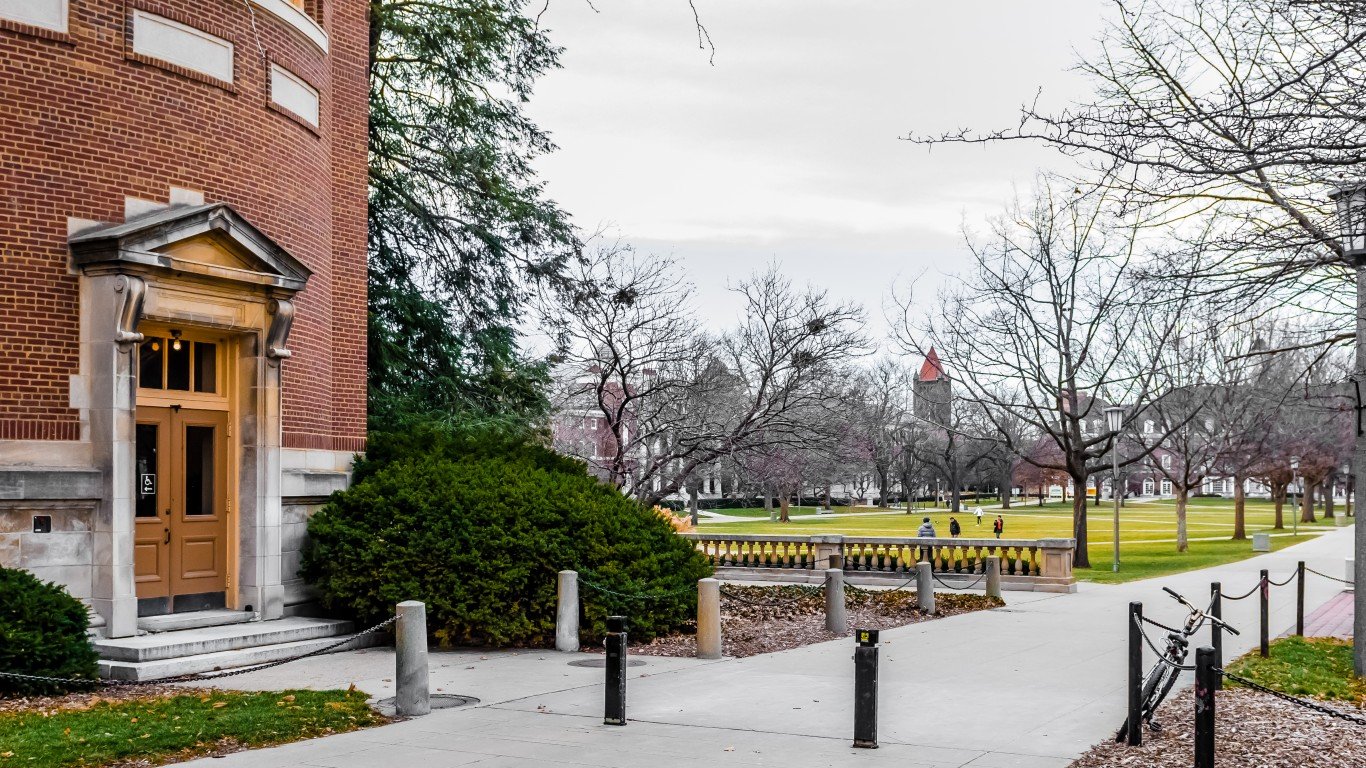
Illinois: Champaign-Urbana
Avg. new daily cases in Champaign in week ending April 12: 24.7 per 100,000
Avg. new daily cases in Champaign in week ending April 5: 20.1 per 100,000
COVID-19 cases in Champaign as of April 12: 67,231 (29,705.8 per 100,000)
Peak pandemic unemployment in Champaign: 12.2% (April 2020)
Champaign population: 226,323 (157.7 people per sq. mi.)

Indiana: Lafayette-West Lafayette
Avg. new daily cases in Lafayette in week ending April 12: 5.9 per 100,000
Avg. new daily cases in Lafayette in week ending April 5: 6.3 per 100,000
COVID-19 cases in Lafayette as of April 12: 58,830 (25,741.6 per 100,000)
Peak pandemic unemployment in Lafayette: 13.8% (April 2020)
Lafayette population: 228,541 (139.1 people per sq. mi.)
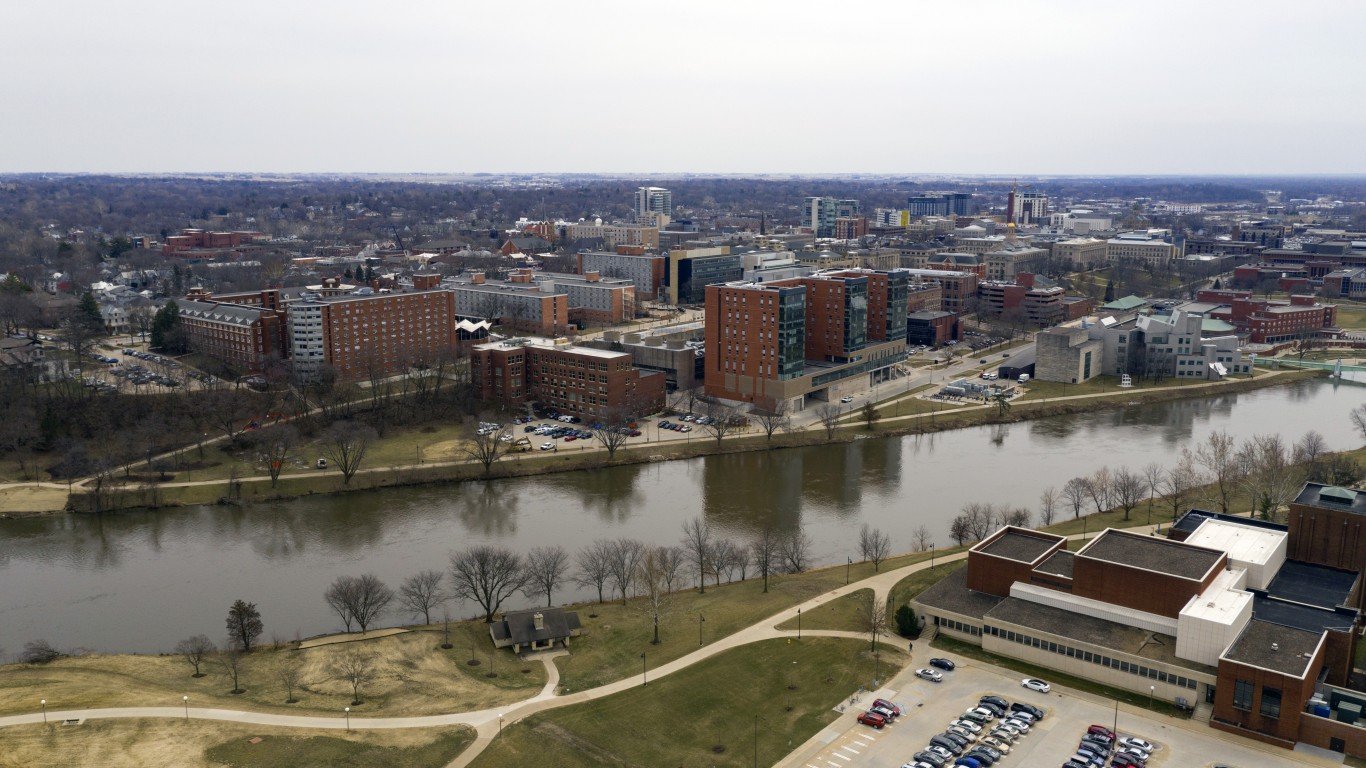
Iowa: Iowa City
Avg. new daily cases in Iowa City in week ending April 12: 8.5 per 100,000
Avg. new daily cases in Iowa City in week ending April 5: 3.6 per 100,000
COVID-19 cases in Iowa City as of April 12: 39,673 (23,244.5 per 100,000)
Peak pandemic unemployment in Iowa City: 10.1% (April 2020)
Iowa City population: 170,677 (144.3 people per sq. mi.)
These are all the counties in Iowa where COVID-19 is slowing (and where it’s still getting worse).
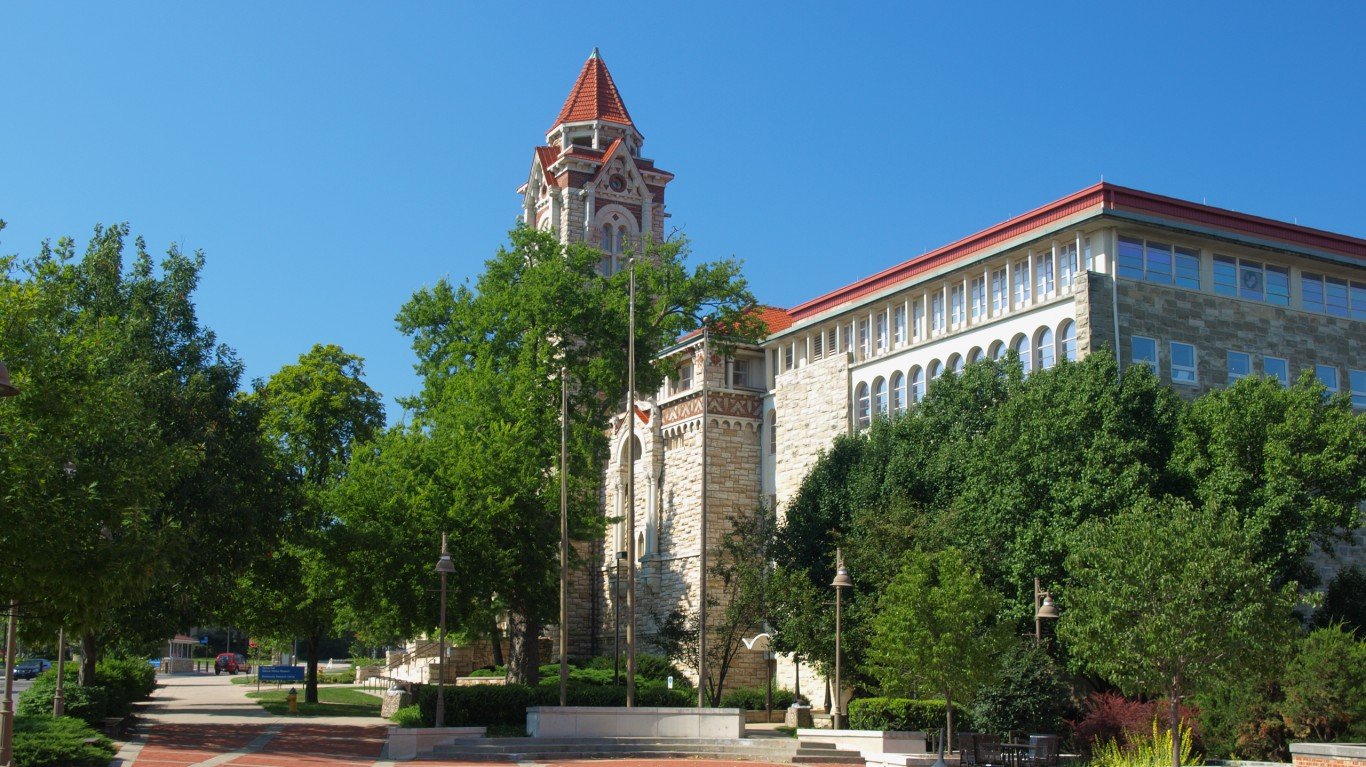
Kansas: Lawrence
Avg. new daily cases in Lawrence in week ending April 12: 4.7 per 100,000
Avg. new daily cases in Lawrence in week ending April 5: 7.5 per 100,000
COVID-19 cases in Lawrence as of April 12: 25,412 (21,125.6 per 100,000)
Peak pandemic unemployment in Lawrence: 12.1% (April 2020)
Lawrence population: 120,290 (263.9 people per sq. mi.)
These are all the counties in Kansas where COVID-19 is slowing (and where it’s still getting worse).
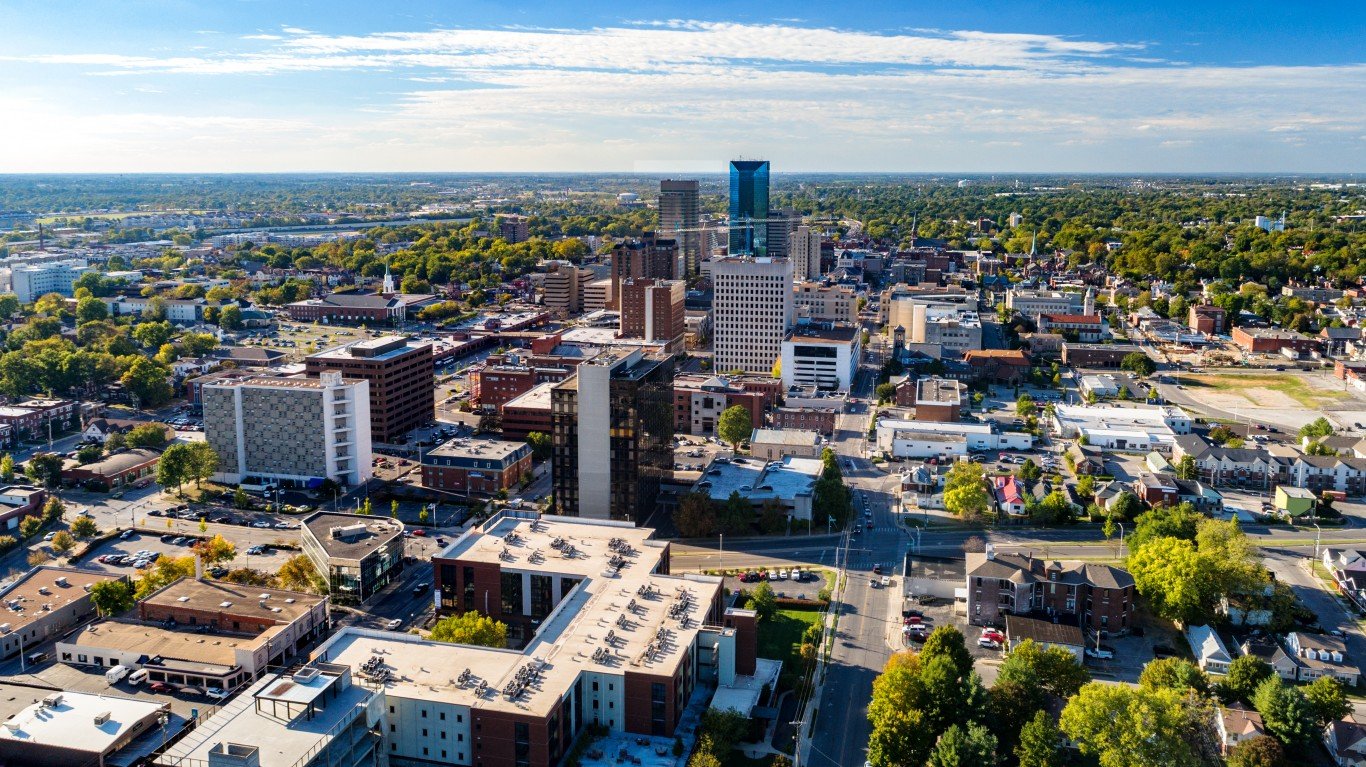
Kentucky: Lexington-Fayette
Avg. new daily cases in Lexington in week ending April 12: 8.9 per 100,000
Avg. new daily cases in Lexington in week ending April 5: 20.9 per 100,000
COVID-19 cases in Lexington as of April 12: 149,791 (29,333.6 per 100,000)
Peak pandemic unemployment in Lexington: 15.8% (April 2020)
Lexington population: 510,647 (347.7 people per sq. mi.)

Louisiana: New Orleans-Metairie
Avg. new daily cases in New Orleans in week ending April 12: 3.2 per 100,000
Avg. new daily cases in New Orleans in week ending April 5: 2.7 per 100,000
COVID-19 cases in New Orleans as of April 12: 306,005 (24,137.1 per 100,000)
Peak pandemic unemployment in New Orleans: 20.0% (April 2020)
New Orleans population: 1,267,777 (396.0 people per sq. mi.)

Maine: Bangor
Avg. new daily cases in Bangor in week ending April 12: 16.7 per 100,000
Avg. new daily cases in Bangor in week ending April 5: 17.7 per 100,000
COVID-19 cases in Bangor as of April 12: 27,554 (18,154.6 per 100,000)
Peak pandemic unemployment in Bangor: 9.6% (April 2020)
Bangor population: 151,774 (44.7 people per sq. mi.)
These are all the counties in Maine where COVID-19 is slowing (and where it’s still getting worse).
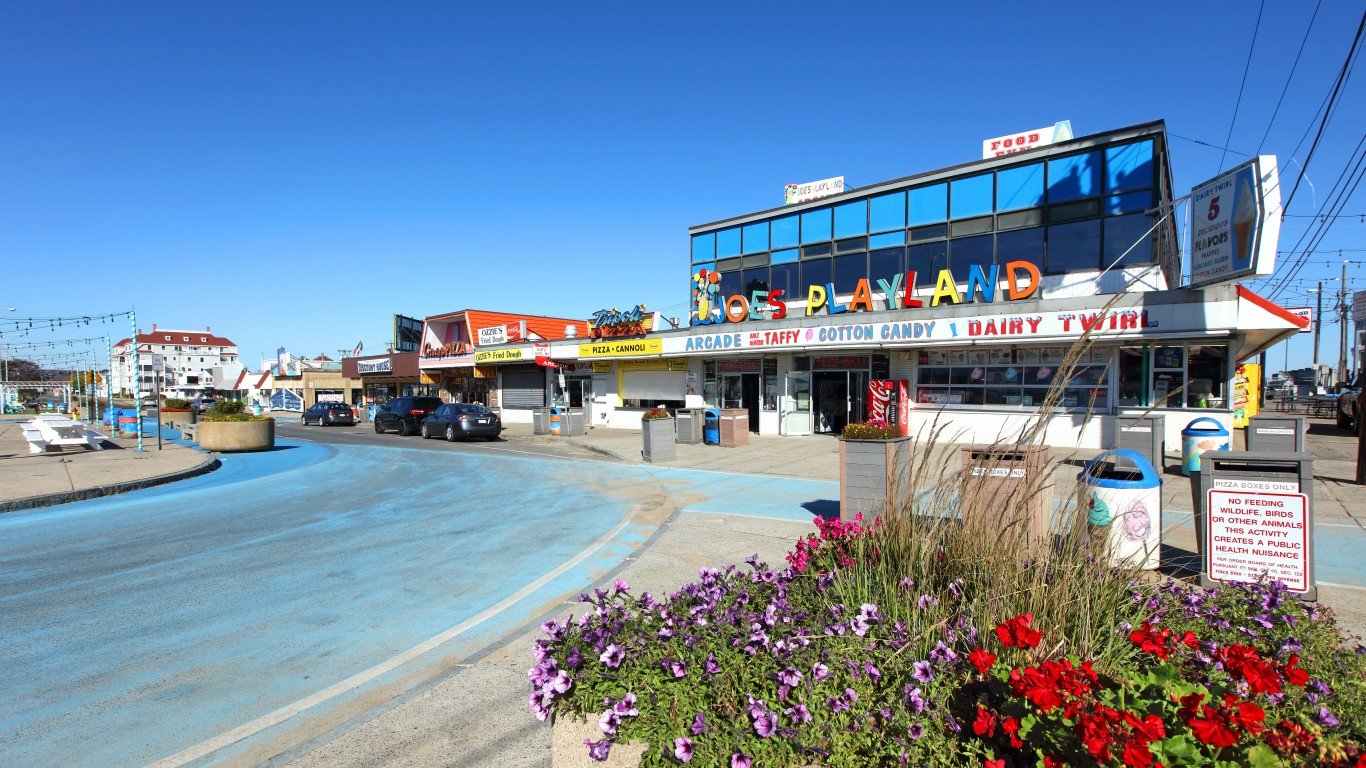
Maryland: Salisbury, MD-DE
Avg. new daily cases in Salisbury in week ending April 12: 6.2 per 100,000
Avg. new daily cases in Salisbury in week ending April 5: 8.3 per 100,000
COVID-19 cases in Salisbury as of April 12: 94,972 (23,483.7 per 100,000)
Peak pandemic unemployment in Salisbury: 16.0% (April 2020)
Salisbury population: 404,417 (192.7 people per sq. mi.)

Massachusetts: Pittsfield
Avg. new daily cases in Pittsfield in week ending April 12: 23.2 per 100,000
Avg. new daily cases in Pittsfield in week ending April 5: 16.2 per 100,000
COVID-19 cases in Pittsfield as of April 12: 23,333 (18,456.0 per 100,000)
Peak pandemic unemployment in Pittsfield: 18.3% (June 2020)
Pittsfield population: 126,425 (136.4 people per sq. mi.)

Michigan: Ann Arbor
Avg. new daily cases in Ann Arbor in week ending April 12: 25.7 per 100,000
Avg. new daily cases in Ann Arbor in week ending April 5: 19.1 per 100,000
COVID-19 cases in Ann Arbor as of April 12: 75,356 (20,533.0 per 100,000)
Peak pandemic unemployment in Ann Arbor: 15.5% (April 2020)
Ann Arbor population: 367,000 (519.9 people per sq. mi.)

Minnesota: Rochester
Avg. new daily cases in Rochester in week ending April 12: 16.2 per 100,000
Avg. new daily cases in Rochester in week ending April 5: 18.2 per 100,000
COVID-19 cases in Rochester as of April 12: 57,081 (26,188.3 per 100,000)
Peak pandemic unemployment in Rochester: 9.7% (May 2020)
Rochester population: 217,964 (88.0 people per sq. mi.)
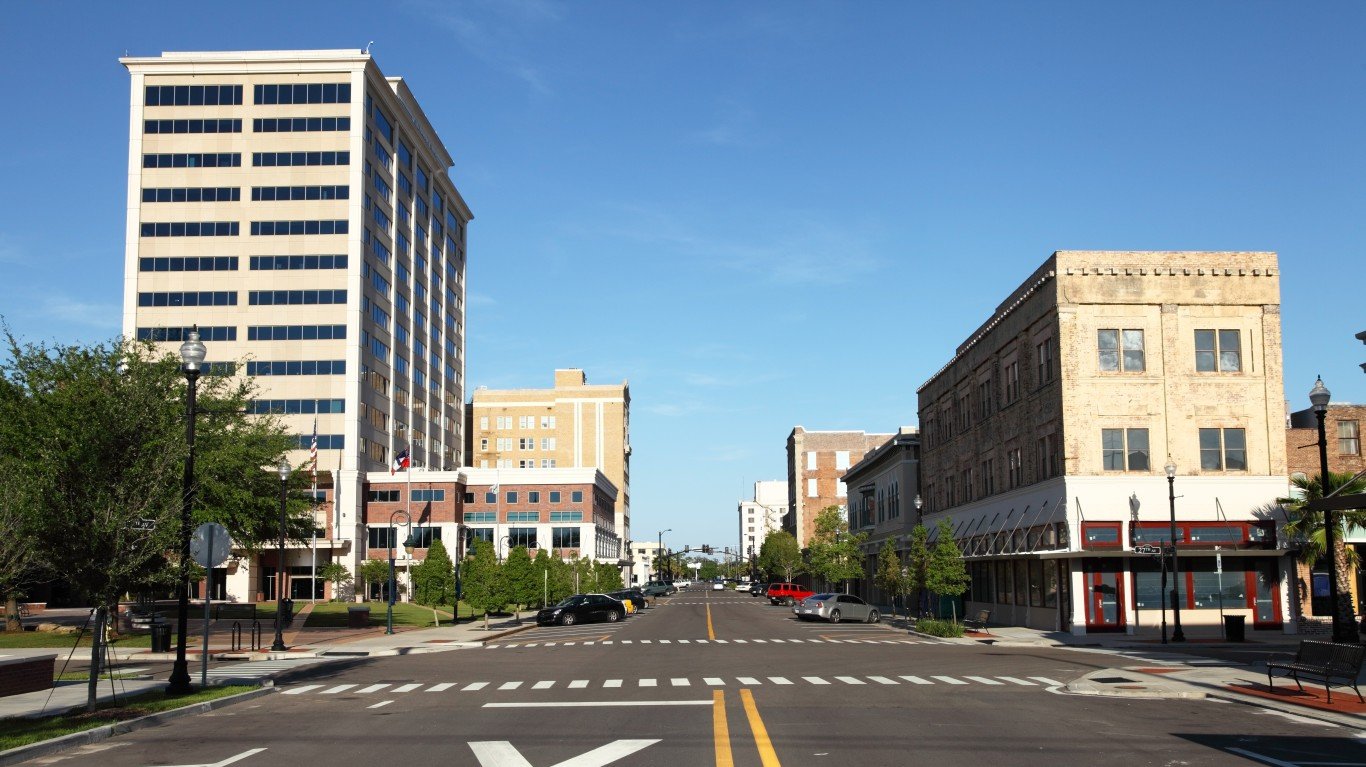
Mississippi: Gulfport-Biloxi
Avg. new daily cases in Gulfport in week ending April 12: 3.9 per 100,000
Avg. new daily cases in Gulfport in week ending April 5: 2.8 per 100,000
COVID-19 cases in Gulfport as of April 12: 108,069 (26,223.0 per 100,000)
Peak pandemic unemployment in Gulfport: 22.3% (April 2020)
Gulfport population: 412,115 (186.0 people per sq. mi.)

Missouri: St. Louis, MO-IL
Avg. new daily cases in St. Louis in week ending April 12: 4.9 per 100,000
Avg. new daily cases in St. Louis in week ending April 5: 5.6 per 100,000
COVID-19 cases in St. Louis as of April 12: 651,191 (23,213.8 per 100,000)
Peak pandemic unemployment in St. Louis: 11.6% (April 2020)
St. Louis population: 2,805,190 (356.7 people per sq. mi.)

Montana: Missoula
Avg. new daily cases in Missoula in week ending April 12: 4.3 per 100,000
Avg. new daily cases in Missoula in week ending April 5: 3.8 per 100,000
COVID-19 cases in Missoula as of April 12: 27,289 (23,262.5 per 100,000)
Peak pandemic unemployment in Missoula: 13.3% (April 2020)
Missoula population: 117,309 (45.2 people per sq. mi.)

Nebraska: Lincoln
Avg. new daily cases in Lincoln in week ending April 12: 5.0 per 100,000
Avg. new daily cases in Lincoln in week ending April 5: 8.0 per 100,000
COVID-19 cases in Lincoln as of April 12: 81,646 (24,716.6 per 100,000)
Peak pandemic unemployment in Lincoln: 9.6% (April 2020)
Lincoln population: 330,329 (234.4 people per sq. mi.)

Nevada: Carson City
Avg. new daily cases in Carson City in week ending April 12: 13.6 per 100,000
Avg. new daily cases in Carson City in week ending April 5: 17.1 per 100,000
COVID-19 cases in Carson City as of April 12: 14,886 (27,177.6 per 100,000)
Peak pandemic unemployment in Carson City: 21.0% (April 2020)
Carson City population: 54,773 (378.6 people per sq. mi.)
These are all the counties in Nevada where COVID-19 is slowing (and where it’s still getting worse).

New Hampshire: Manchester-Nashua
Avg. new daily cases in Manchester in week ending April 12: 4.3 per 100,000
Avg. new daily cases in Manchester in week ending April 5: 12.7 per 100,000
COVID-19 cases in Manchester as of April 12: 97,391 (23,579.4 per 100,000)
Peak pandemic unemployment in Manchester: 17.5% (April 2020)
Manchester population: 413,035 (471.4 people per sq. mi.)

New Jersey: Trenton-Princeton
Avg. new daily cases in Trenton in week ending April 12: 16.2 per 100,000
Avg. new daily cases in Trenton in week ending April 5: 13.7 per 100,000
COVID-19 cases in Trenton as of April 12: 76,546 (20,805.0 per 100,000)
Peak pandemic unemployment in Trenton: 12.4% (June 2020)
Trenton population: 367,922 (1,638.4 people per sq. mi.)

New Mexico: Las Cruces
Avg. new daily cases in Las Cruces in week ending April 12: 12.8 per 100,000
Avg. new daily cases in Las Cruces in week ending April 5: 4.8 per 100,000
COVID-19 cases in Las Cruces as of April 12: 62,989 (29,152.3 per 100,000)
Peak pandemic unemployment in Las Cruces: 12.6% (July 2020)
Las Cruces population: 216,069 (56.7 people per sq. mi.)
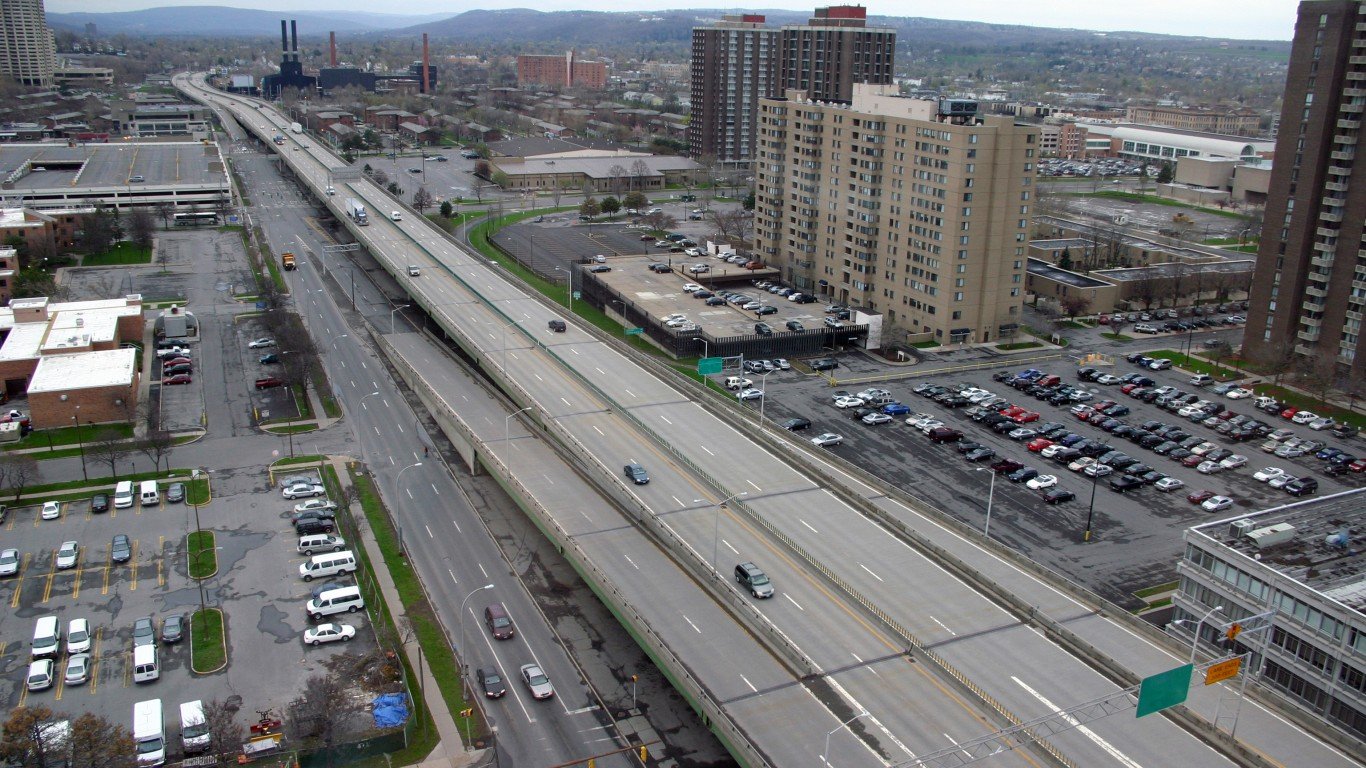
New York: Syracuse
Avg. new daily cases in Syracuse in week ending April 12: 50.7 per 100,000
Avg. new daily cases in Syracuse in week ending April 5: 48.3 per 100,000
COVID-19 cases in Syracuse as of April 12: 154,697 (23,711.4 per 100,000)
Peak pandemic unemployment in Syracuse: 16.7% (April 2020)
Syracuse population: 652,416 (273.6 people per sq. mi.)
North Carolina: Goldsboro
Avg. new daily cases in Goldsboro in week ending April 12: 93.6 per 100,000
Avg. new daily cases in Goldsboro in week ending April 5: 86.2 per 100,000
COVID-19 cases in Goldsboro as of April 12: 30,929 (25,022.9 per 100,000)
Peak pandemic unemployment in Goldsboro: 10.1% (April 2020)
Goldsboro population: 123,603 (223.5 people per sq. mi.)
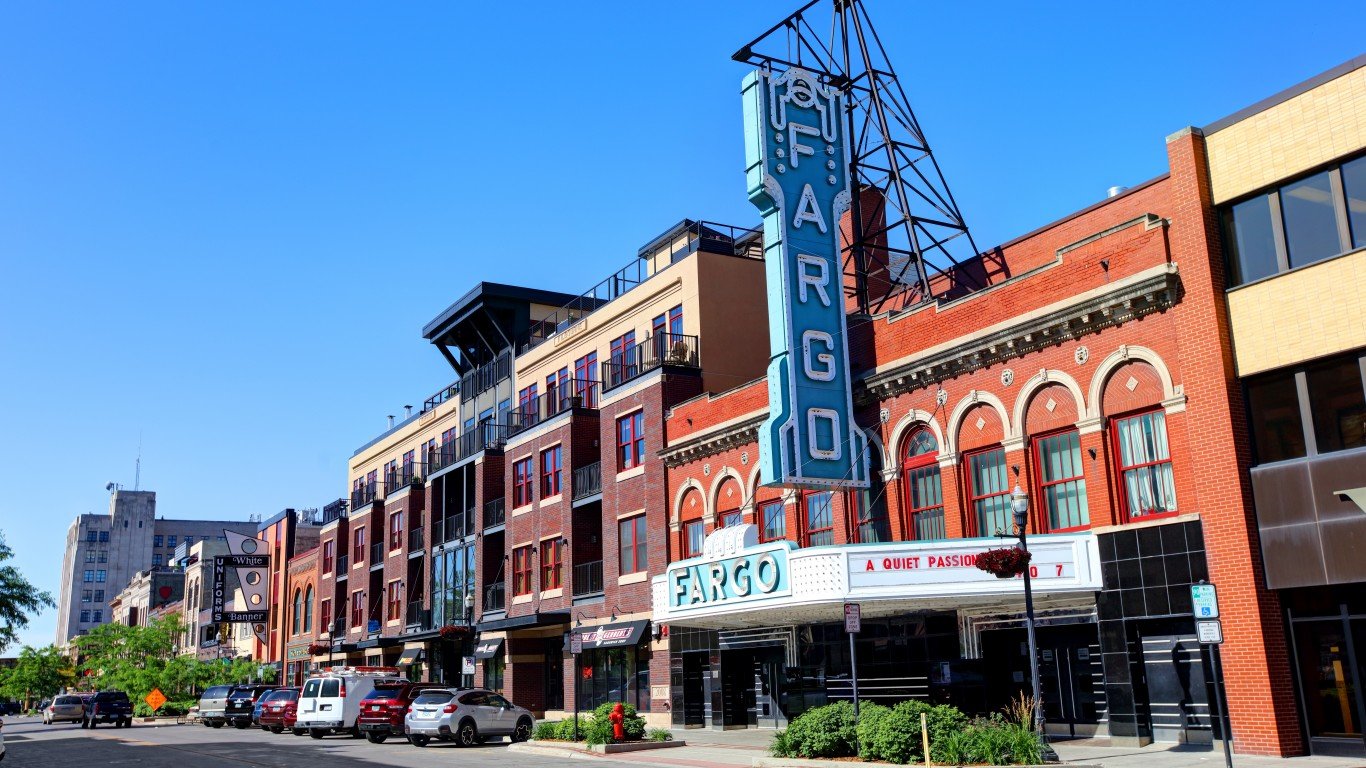
North Dakota: Fargo, ND-MN
Avg. new daily cases in Fargo in week ending April 12: 4.7 per 100,000
Avg. new daily cases in Fargo in week ending April 5: 5.0 per 100,000
COVID-19 cases in Fargo as of April 12: 78,731 (32,747.1 per 100,000)
Peak pandemic unemployment in Fargo: 7.7% (April 2020)
Fargo population: 240,421 (85.5 people per sq. mi.)

Ohio: Cincinnati, OH-KY-IN
Avg. new daily cases in Cincinnati in week ending April 12: 6.9 per 100,000
Avg. new daily cases in Cincinnati in week ending April 5: 10.7 per 100,000
COVID-19 cases in Cincinnati as of April 12: 538,640 (24,464.3 per 100,000)
Peak pandemic unemployment in Cincinnati: 14.5% (April 2020)
Cincinnati population: 2,201,741 (483.6 people per sq. mi.)
These are all the counties in Ohio where COVID-19 is slowing (and where it’s still getting worse).

Oklahoma: Lawton
Avg. new daily cases in Lawton in week ending April 12: 10.0 per 100,000
Avg. new daily cases in Lawton in week ending April 5: 12.3 per 100,000
COVID-19 cases in Lawton as of April 12: 34,441 (26,987.1 per 100,000)
Peak pandemic unemployment in Lawton: 19.5% (April 2020)
Lawton population: 127,620 (75.0 people per sq. mi.)

Oregon: Corvallis
Avg. new daily cases in Corvallis in week ending April 12: 15.7 per 100,000
Avg. new daily cases in Corvallis in week ending April 5: 10.0 per 100,000
COVID-19 cases in Corvallis as of April 12: 15,208 (16,692.5 per 100,000)
Peak pandemic unemployment in Corvallis: 10.6% (April 2020)
Corvallis population: 91,107 (134.8 people per sq. mi.)
These are all the counties in Oregon where COVID-19 is slowing (and where it’s still getting worse).

Pennsylvania: Philadelphia-Camden-Wilmington, PA-NJ-DE-MD
Avg. new daily cases in Philadelphia in week ending April 12: 7.9 per 100,000
Avg. new daily cases in Philadelphia in week ending April 5: 6.5 per 100,000
COVID-19 cases in Philadelphia as of April 12: 1,262,184 (20,762.6 per 100,000)
Peak pandemic unemployment in Philadelphia: 15.3% (April 2020)
Philadelphia population: 6,079,130 (1,320.9 people per sq. mi.)

Rhode Island: Providence-Warwick, RI-MA
Avg. new daily cases in Providence in week ending April 12: 16.2 per 100,000
Avg. new daily cases in Providence in week ending April 5: 16.5 per 100,000
COVID-19 cases in Providence as of April 12: 485,452 (29,998.2 per 100,000)
Peak pandemic unemployment in Providence: 18.5% (April 2020)
Providence population: 1,618,268 (1,019.8 people per sq. mi.)

South Carolina: Spartanburg
Avg. new daily cases in Spartanburg in week ending April 12: 16.5 per 100,000
Avg. new daily cases in Spartanburg in week ending April 5: 3.6 per 100,000
COVID-19 cases in Spartanburg as of April 12: 94,825 (30,825.7 per 100,000)
Peak pandemic unemployment in Spartanburg: 15.5% (April 2020)
Spartanburg population: 307,617 (380.7 people per sq. mi.)
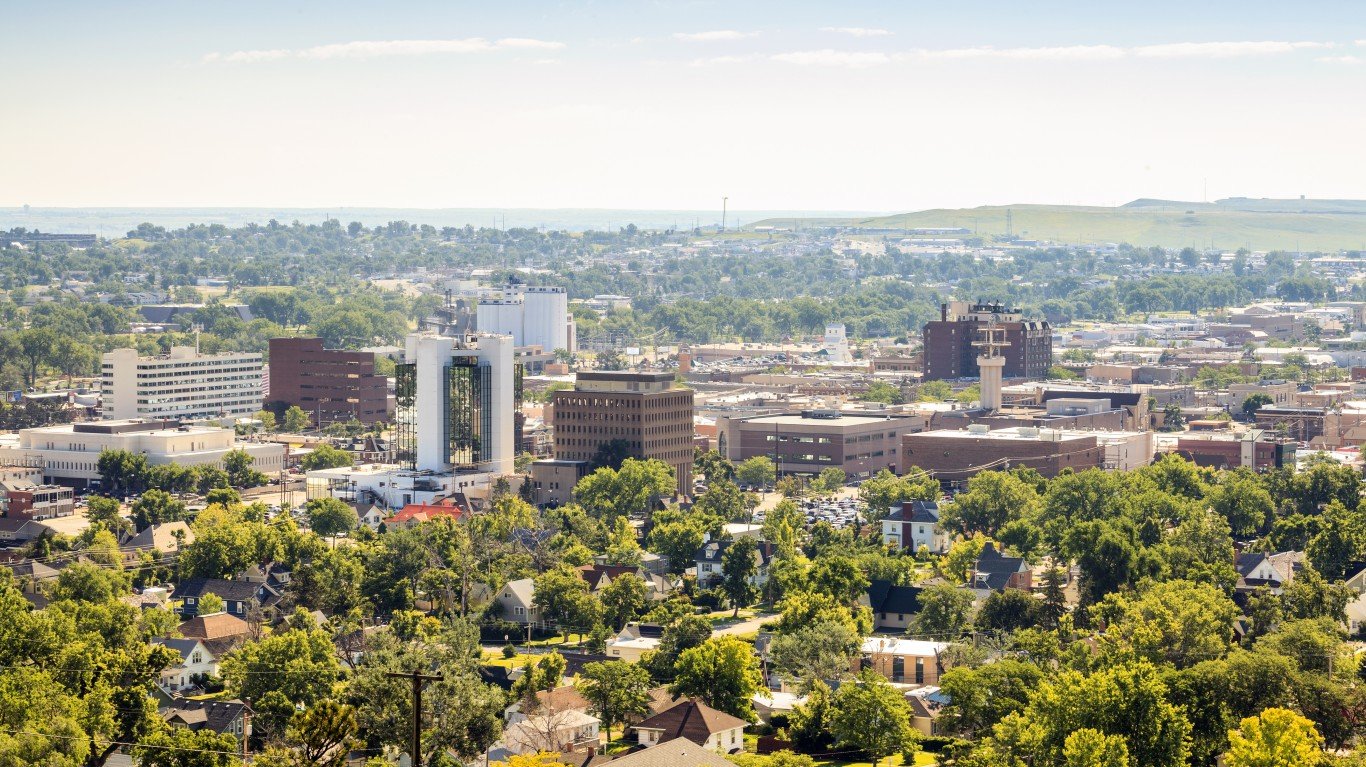
South Dakota: Rapid City
Avg. new daily cases in Rapid City in week ending April 12: 2.3 per 100,000
Avg. new daily cases in Rapid City in week ending April 5: 2.9 per 100,000
COVID-19 cases in Rapid City as of April 12: 39,678 (28,668.7 per 100,000)
Peak pandemic unemployment in Rapid City: 13.8% (April 2020)
Rapid City population: 138,402 (22.2 people per sq. mi.)

Tennessee: Chattanooga, TN-GA
Avg. new daily cases in Chattanooga in week ending April 12: 10.5 per 100,000
Avg. new daily cases in Chattanooga in week ending April 5: 8.3 per 100,000
COVID-19 cases in Chattanooga as of April 12: 147,450 (26,509.8 per 100,000)
Peak pandemic unemployment in Chattanooga: 13.7% (April 2020)
Chattanooga population: 556,209 (266.3 people per sq. mi.)
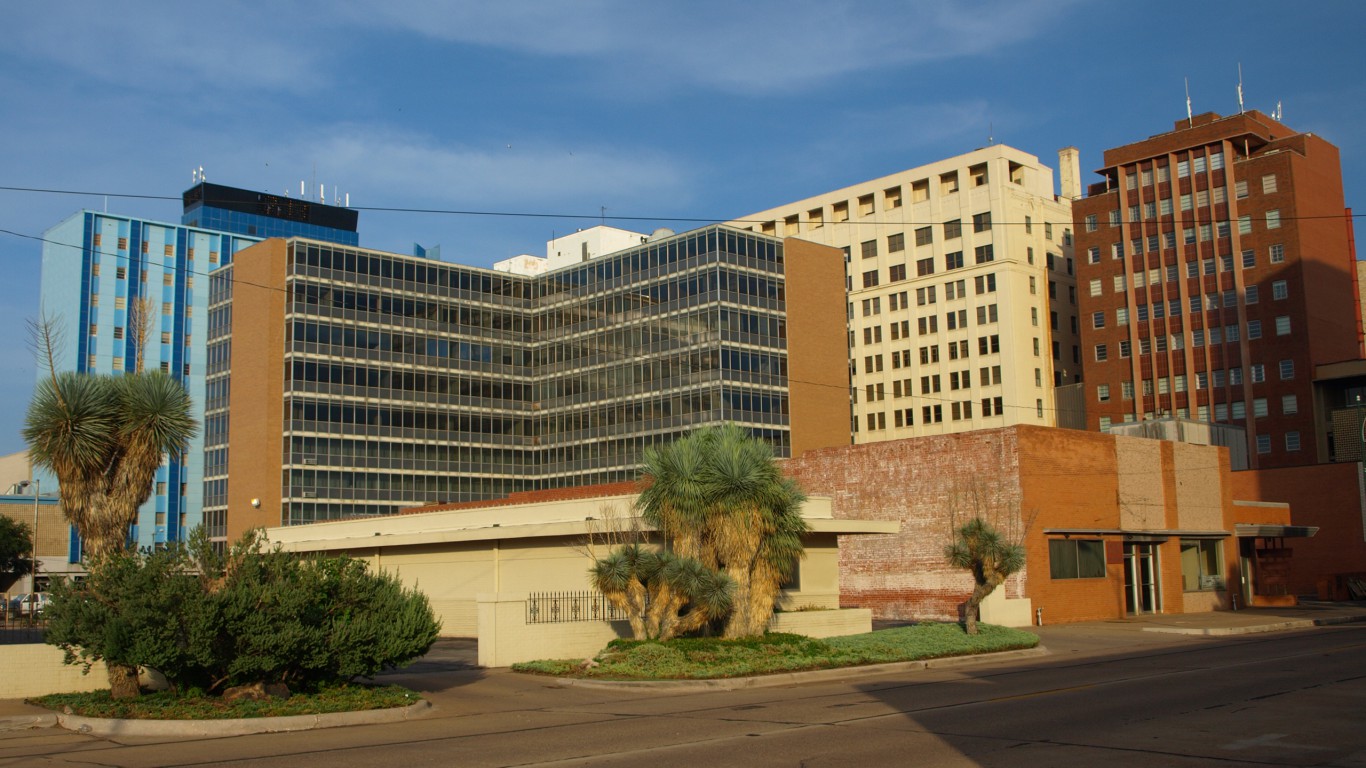
Texas: Wichita Falls
Avg. new daily cases in Wichita Falls in week ending April 12: 45.8 per 100,000
Avg. new daily cases in Wichita Falls in week ending April 5: 28.7 per 100,000
COVID-19 cases in Wichita Falls as of April 12: 32,834 (23,122.7 per 100,000)
Peak pandemic unemployment in Wichita Falls: 11.8% (April 2020)
Wichita Falls population: 141,999 (82.7 people per sq. mi.)
These are all the counties in Texas where COVID-19 is slowing (and where it’s still getting worse).

Utah: Salt Lake City
Avg. new daily cases in Salt Lake City in week ending April 12: 2.0 per 100,000
Avg. new daily cases in Salt Lake City in week ending April 5: 4.9 per 100,000
COVID-19 cases in Salt Lake City as of April 12: 363,009 (30,224.5 per 100,000)
Peak pandemic unemployment in Salt Lake City: 11.3% (April 2020)
Salt Lake City population: 1,201,043 (156.3 people per sq. mi.)
These are all the counties in Utah where COVID-19 is slowing (and where it’s still getting worse).

Vermont: Burlington-South Burlington
Avg. new daily cases in Burlington in week ending April 12: 30.4 per 100,000
Avg. new daily cases in Burlington in week ending April 5: 25.3 per 100,000
COVID-19 cases in Burlington as of April 12: 42,000 (19,197.0 per 100,000)
Peak pandemic unemployment in Burlington: 14.8% (April 2020)
Burlington population: 218,784 (174.7 people per sq. mi.)

Virginia: Charlottesville
Avg. new daily cases in Charlottesville in week ending April 12: 17.1 per 100,000
Avg. new daily cases in Charlottesville in week ending April 5: 18.1 per 100,000
COVID-19 cases in Charlottesville as of April 12: 38,108 (17,688.0 per 100,000)
Peak pandemic unemployment in Charlottesville: 10.2% (April 2020)
Charlottesville population: 215,445 (131.0 people per sq. mi.)

Washington: Seattle-Tacoma-Bellevue
Avg. new daily cases in Seattle in week ending April 12: 24.4 per 100,000
Avg. new daily cases in Seattle in week ending April 5: 12.5 per 100,000
COVID-19 cases in Seattle as of April 12: 723,841 (18,697.5 per 100,000)
Peak pandemic unemployment in Seattle: 17.3% (April 2020)
Seattle population: 3,871,323 (659.2 people per sq. mi.)

West Virginia: Morgantown
Avg. new daily cases in Morgantown in week ending April 12: 6.4 per 100,000
Avg. new daily cases in Morgantown in week ending April 5: 7.0 per 100,000
COVID-19 cases in Morgantown as of April 12: 33,874 (24,342.3 per 100,000)
Peak pandemic unemployment in Morgantown: 13.3% (April 2020)
Morgantown population: 139,157 (137.9 people per sq. mi.)

Wisconsin: Madison
Avg. new daily cases in Madison in week ending April 12: 18.9 per 100,000
Avg. new daily cases in Madison in week ending April 5: 15.0 per 100,000
COVID-19 cases in Madison as of April 12: 154,952 (23,702.9 per 100,000)
Peak pandemic unemployment in Madison: 11.6% (April 2020)
Madison population: 653,725 (197.5 people per sq. mi.)
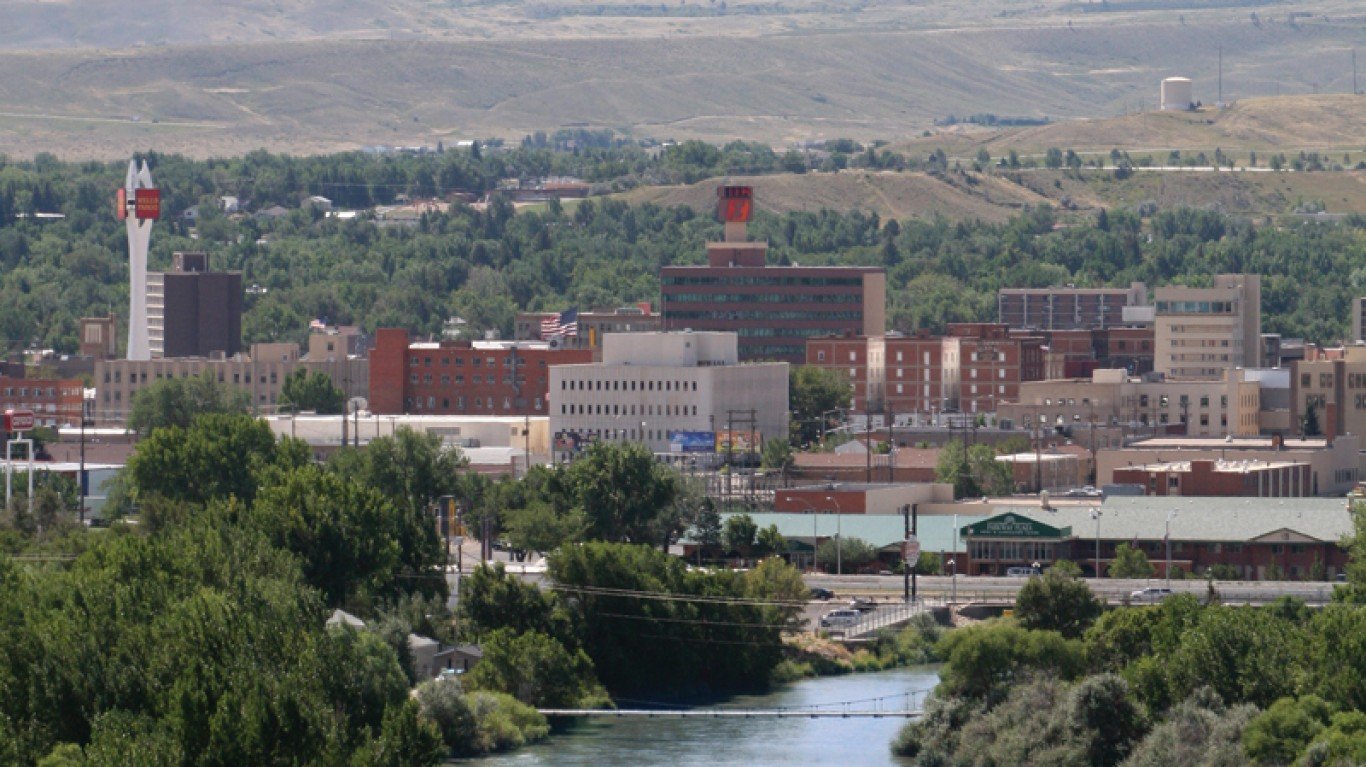
Wyoming: Casper
Avg. new daily cases in Casper in week ending April 12: 5.0 per 100,000
Avg. new daily cases in Casper in week ending April 5: 2.3 per 100,000
COVID-19 cases in Casper as of April 12: 22,273 (27,725.8 per 100,000)
Peak pandemic unemployment in Casper: 12.6% (April 2020)
Casper population: 80,333 (15.0 people per sq. mi.)
Click here to see all coronavirus data for every state.
Sponsored: Attention Savvy Investors: Speak to 3 Financial Experts – FREE
Ever wanted an extra set of eyes on an investment you’re considering? Now you can speak with up to 3 financial experts in your area for FREE. By simply
clicking here you can begin to match with financial professionals who can help guide you through the financial decisions you’re making. And the best part? The first conversation with them is free.
Click here to match with up to 3 financial pros who would be excited to help you make financial decisions.
Thank you for reading! Have some feedback for us?
Contact the 24/7 Wall St. editorial team.
